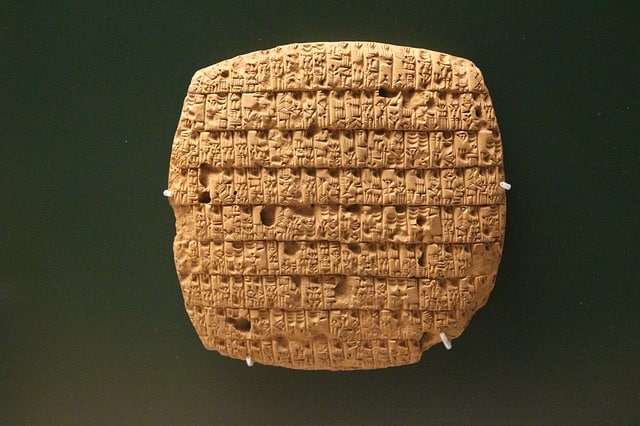
Cuneiform inscriptions are among the oldest forms of writing.
The first thing to do to understand the meaning of the term cuneiform is to determine its origin. Thus we would have to state that this word was coined by an English professor named Thomas Hude (1636-1703) with the clear objective of referring to the type of writing that was carried out in Mesopotamia about three thousand years before Christ.
Thus he created the term based on two Latin words: “cuneus”, which can be translated as “wedge”, and “forme”, which is equivalent to “form”. And in this way it came to show the wedge-like appearance that the characters of that writing had because they were made with a stem with that aforementioned shape.
Cuneiform concept
Cuneiform is something that is shaped like a wedge . A wedge, on the other hand, is a piece that ends in a very acute dihedral angle . The adjective cuneiform is usually used to refer to certain characters with this form that some Asian peoples used in ancient times.
Cuneiform writing is considered one of the oldest forms of writing . Clay tablets with these characters found in Umm el-Qaab constitute the oldest written documents ever found: evidence indicates that they were created between 3,400 and 3,200 BC .
The Sumerians are noted as the inventors of cuneiform writing, completing an evolution that began with pictograms that represented objects and words. Cuneiform characters were adopted by other languages and inspired the alphabets of ancient Persian.

The Sumerian people are mentioned as the creators of cuneiform writing.
clay tablets
Cuneiform writing was developed on wet clay tablets with a wedge-shaped plant stem. Over time, other materials began to be used to engrave the characters, such as stone or metal.
On some tablets, experts have managed to count about 2,000 different cuneiform signs . However, this amount does not seem to be very common, but the characters frequently used were about 600.
Cuneiform writing in the "Code of Hammurabi"
One of the most important and ancient documents that have been preserved and that includes cuneiform writing characters is the so-called “Code of Hammurabi”. This was engraved on a stele more than two meters high, it was made at the request of King Hammurabi of Babylon and it includes one of the oldest groups of laws that exist.
Specifically, it was carried out in the year 1760 BC and all its legal content is based on the well-known law of Talion, which can be explained by the popular saying "an eye for an eye and a tooth for a tooth." This means that it establishes the imposition of punishments that resemble the crimes committed. For all these reasons, the Code of Hammurabi was placed in the squares so that anyone could know the laws that existed and what they would be exposed to if they broke them.
The notion in botany and anatomy
For botany , cuneiform is the part of some plants that has this shape. One can speak, in this sense, of cuneiform petals or cuneiform leaves.
In the field of anatomy , cuneiform bones are those with a prismatic shape that are found in the tarsus of mammals. The human being , for example, has three cuneiform bones in the anterior part of the second row of the tarsus.
